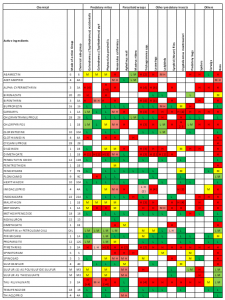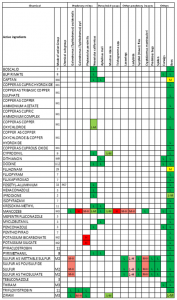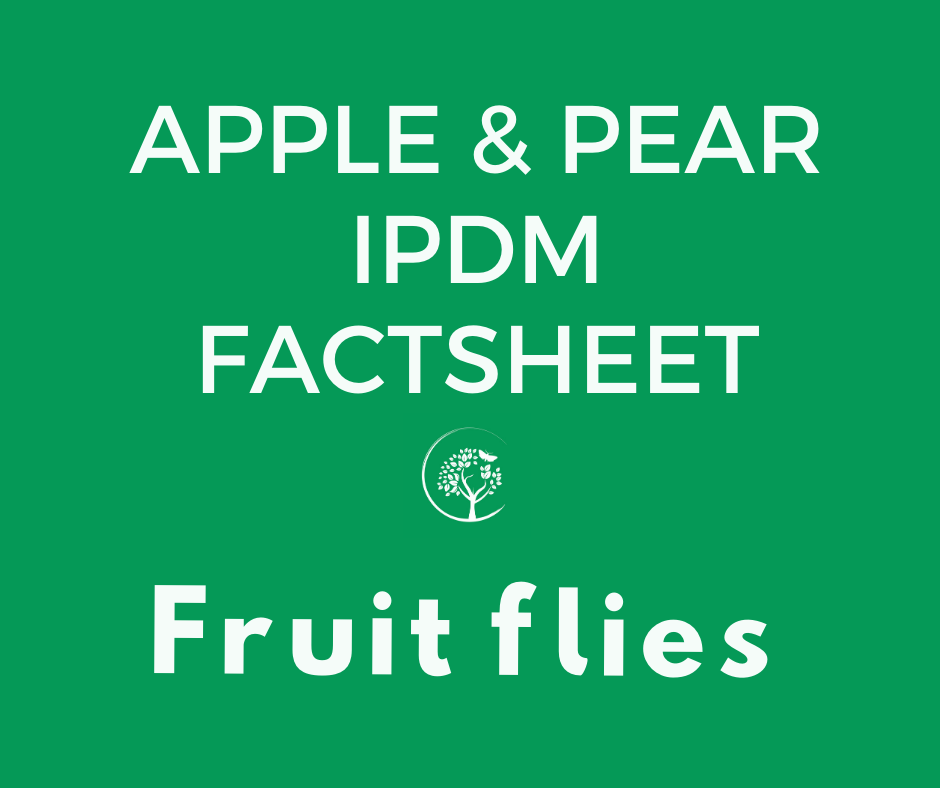To download the below information in printable pdf format click on IPDM Factsheet – Fruit flies
IPDM Quick Facts
- Two species of fruit flies have a major impact on pome fruit production in Australia.
- Queensland fruit fly (QFF or Qfly), Bactrocera tryoni, is a native tephritid whose natural range has expanded southwards in the eastern states where it is now officially considered endemic to the Northern Territory, Queensland, New South Wales and Victoria although not all pome fruit areas in Victoria are infested. Sporadic outbreaks occur in other states.
- Mediterranean fruit fly (MFF or Medfly), Ceratitis capitata, is currently restricted to areas in Western Australia from Esperance in the south to Derby in the north, although sporadic outbreaks occur in parts of South Australia.
- Trapping to detect presence of adult flies and prediction of key periods in their life-cycle will improve the timing and efficacy of control measures.
- Monitoring traps for QFF use Cue-lure as the attractant for male flies.
- Trimedlure- Extended is used as the attractant for male MFF.
- Methyl-eugenol is used in surveillance traps to detect presence of other exotic fruit fly species.
- On-farm quarantine, orchard hygiene, monitoring and surveillance traps, and area-wide co-operation to manage host plants are critical to good fruit fly control.
- Protein is important for freshly emerged fruit flies to mature sexually and for females to develop eggs.
- Protein baits attract both sexes of immature fruit flies.
- Protein baits are not attractant to sexually mature flies except for older females that have laid eggs and need a protein feed to develop another batch of eggs.
- The effectiveness of protein baits depends on the type of protein, the toxicant added to the protein, the formulation (liquid, gel, etc) of the bait, placement, and timing of the baiting.
- Protein baits are short-range attractants so traps need to be placed no more than about 6m apart and bait sprays should be applied as coarse drops.
- Male annihilation technique uses is an attract-and-kill technique for male fruit flies and is based on combining pheromone and a suitable registered toxicant in blocks or pads placed at medium to high density in orchard trees.
- Traps baited with lures containing host plant volatiles are available for monitoring and mass-trapping.
- Recent legislation is some states require traps with sticky surfaces to be enclosed in mesh or another device to prevent access by small vertebrates such as lizards, native mice, birds etc.
- Sterile Insect Technique (SIT) uses mass-release of sterile flies to suppress wild fly populations.
- Cover sprays against fruit flies can decimate beneficial predators and parasitoids
Management
The main means of fruit fly dispersal is through transport of eggs or larvae in infested fruit. Fruit flies are often transported over large distances by travellers. Domestic quarantine limits the distribution of pests between states and excludes fruit flies from established fruit fly free regions. These quarantine zones are regulated and monitored by state government departments of agriculture.
The fruit fly concerns of the states vary in accordance with which fly species are endemic and which are likely to pose incursion threats. Specific details on the quarantine measure relating to individual states can be found on the websites of their departments of agriculture and primary industries.
Orchard hygiene
On-farm quarantine protocols to prevent visitors, contractors and staff bringing potentially infested fruit onto the property is a good first step in management of any pests or diseases. Obvious signage at all entry points will reinforce the message. Businesses that pack or store fruit for other growers need to ensure that they have strict guidelines in place that either impose standards for delivery of fruit or deal with ways to process substandard and/or infested fruit, including disinfection of bins.
It is important to remove and destroy waste fruit which is, or could become, infested with fruit fly. Fruit which has fallen or is left hanging after harvest should be removed and destroyed. Remember that even fruit which appears perfect may harbour infestations so be conservative and treat all unharvested fruit in this way.
Burying waste fruit is not a practical option for commercial orchards but if it is attempted the fruit must be buried deeply (>1m) to prevent any flies emerging from pupae from finding their way to the surface. Do not dump untreated fruit in or near the orchard because this can become a source of flies to infest other fruit. Cold storage at a core temperature of 1oC or below for 3 weeks or more will kill maggots in the fruit, so pome fruit rejected from the packing line is low risk because it is usually subjected to a long period of cold storage before sale. Be aware that it may take several days for fruit in the middle of a stack of full bins to reach a core temperature of 1oC or below. Cold storage of fruit collected from the orchard floor or left on the trees after harvest is not a practical option for commercial orchardists. In-field pest management approaches to control the pest prior to the fruit becoming susceptible to attack are essential.
Any host plants that are unwanted or regularly remain unharvested should be removed and destroyed. This includes trees from around sheds and houses, along boundaries and irrigation channels, and roadsides (if permitted by local by-laws). These measures will also help with management of other pests such as codling moth, oriental fruit moth, carpophilus beetles, and diseases such as scab.
Recommendations to freeze, boil, or puree waste fruit and feed it to livestock are only applicable to home gardeners, small lot owners, or small scale organic producers. Livestock used for meat, milk, or egg production should not be fed fruit that has been sprayed unless label instructions are strictly followed.
Fruit flies are mobile pests that have wide host ranges and, because each host species generally provides only a relatively short period in which the fruit is suitable for sustaining growth of maggots, they disperse in search of successive suitable hosts. This means that area-wide co-operation amongst a range of stakeholders to manage susceptible host plants is critical to good fruit fly control.
While visual monitoring provides useful information, earlier detection is likely with traps which use pheromone or food baits.
Trapping to detect presence of adult flies and prediction of key periods in their life-cycle will improve the timing and efficacy of control measures. The most common traps used for this purpose use male attractants as lures and a toxicant to kill the insects that enter the trap. Cue-lure is used as the attractant for male QFF and Trimedlure- extended is used as the attractant for male MFF. Government surveillance programs also use traps baited with Methyl-eugenol to detect presence of other exotic fruit fly species and other endemic species that do not respond to either of the other lures.
Traps based on protein baits are available to detect immature flies. Protein is important for freshly emerged fruit flies to mature sexually and for females to develop eggs. Protein baits are not attractant to sexually mature flies except for older females that have laid eggs and need a protein feed to develop another batch of eggs.
Traps containing coloured sticky surfaces and lures based on host plant volatiles to attract egg-laying females are also available. The exposed sticky surfaces need regular maintenance to remain effective because dust and debris that accumulates on the surface reduces its ability to capture the insects. They also tend to capture a range of non-target flying insects. In addition, new animal welfare regulations require traps with sticky surfaces to have mesh or other design elements that prevent small vertebrates from becoming stuck. Considerable effort worldwide, including Australia, is being expended in development of user-friendly female traps.
Traps should be hung in the tree canopy at about head height and about two-thirds of the way out from the trunk, in semi-shade and clear of foliage to allow easy access for the flies through the entry holes in the trap. The traps should be in place in time to detect early activity of overwintered flies. For QFF this should be before 82 DD12.4C from 1st July. There is no value in placing traps in pome fruit trees before flowering. Traps should be placed in evergreen trees or early fruit hosts such as citrus, loquats, and apricots to get an indication of early population trends for prediction of when subsequent generations are likely to occur.
Bait spraying
The effectiveness of protein baits depends on the type of protein, the toxicant added to the protein, the formulation (liquid, gel, etc) of the bait, placement, and timing of the baiting. An organic certified bait is registered and available. Bait sprays should be applied as coarse drops. Bait spraying will only kill adult flies that are foraging for the protein required for the males to become sexually mature and for the females to mature eggs in preparation for mating. It is therefore important that bait spraying is conducted early in each generation before fruit is being stung. Bait spraying does not kill eggs or maggots but by killing adults before they mate it does reduce the number of eggs being laid and therefore the number of maggots produced. Bait spraying is more effective when conducted in the morning because this is when flies are actively foraging. Bait spraying involves application of coarse droplets of protein solution, laced with a pesticide registered for that use, to leaves of trees likely to be harbouring flies. Entire tree coverage is not required and should be avoided so that pesticide residues and phytotoxic effects do not become issues. DO NOT APPLY BY ORCHARD AIRBLAST SPRAYING EQUIPMENT. Bait spraying in commercial orchards requires application of about 30L of the bait spray/ha. This can be achieved using 12volt operated spray equipment mounted to quad bikes, gators, utes, or small tractors. The fine spray nozzles usually fitted to the hand lance should be replaced with a nozzle that gives a coarse spray so that large droplets can be applied. About 60-100mL should be applied to the foliage of each tree (or panel of trellised trees), preferably avoiding spraying of fruit. Flies are attracted to the protein bait by smell. Bait sprays need to be re-applied if there is more than 5mm of rain. Where sprinklers are used for irrigation, they should be set so that they do not spray water into the tree canopy but if that is not avoidable then bait sprays must be applied higher in the canopy than where to irrigation water will hit. IPDM note: Sprinklers set up to wet the canopy will redistribute any pesticide residues and could lead to loss of effectiveness in those parts of the tree. This could lead to establishment of fungal diseases such as scab and allow build up of insects such as woolly apple aphid in lower parts of the tree.
Lure and Kill
Bait spraying is a form of lure and kill, a technique in which insects are attracted to a pesticide-laced lure or bait and are killed when they feed on or contact the lure. Although protein baits can be used in traps for monitoring immature flies the main tool for lure and kill of fruit flies is the Male Annihilation Technique (MAT) which uses the lure solution from monitoring traps (cue-lure for QFF or Trimedlure-Extended for Medfly mixed with a toxicant and impregnated into either a block or pad of porous material like canite fibreboard, cardboard, or felt. Some MAT products simply use the lure/toxicant pad from the standard monitoring traps placed inside an inverted waxed paper cup hung in a tree as a cheap alternative. These MAT devices do not retain the killed flies, and if placed too close to monitoring traps may compete with the traps and give a false indication of fly activity. MAT devices should be placed no closer than 36m to a monitoring trap. Because of this potential interference, some export protocols may forbid use of MAT. Depending on fly pressure the MAT devices may need to be applied at 10-30/ha. They only attract and kill male flies so should be used in conjunction with other female targeted treatments such as baiting and Sterile Insect Technique.
Biological control
Fruit flies have several natural predators and parasitoids. Ants and ground beetles feed on larvae in infested fruit and pupae in the ground. Birds like choughs, poultry including guinea fowl and turkeys, and small vertebrates are generalist predators of insects on the ground.
There are eight species of Braconid wasps that are known to attack QFF in Australia and four of those have a wide Tephritid fly host range which includes Medfly and several other exotic species that are on the Australian quarantine watch list. Diachasmimorpha kraussii and D. tryoni are native wasps that attack 2nd and 3rd instar fruit fly maggots and have been recorded from far north Queensland down to southern inland NSW. Two parasitoids native to SE Asia were introduced into Australia from Hawaii. D.longicaudata has established from North Qld to Lord Howe Island. Fopius arisanus has spread from far north Qld to Sydney. D.tryoni has successfully established against Medfly in other countries.
The parasitoids are susceptible to many pesticides and pesticide-laced baits containing sugars as well as protein may be attractive to the adult parasitoids, leading to mortality. Combination of parasitoid releases and Sterile Insect Technique (SIT) is likely to be successful.
SIT involves the use of mass-reared flies that are sterilised prior to release. The technique has been used in Australia for many years against QFF and Medfly. The flies used in Australia for SIT are sterilised by irradiation in the pupal stage and transported to rear-out facilities where they mature and are distributed to release sites. The sterile flies are released in large numbers and the mating of sterile male flies with wild females produces sterile eggs and no offspring. SIT is a useful technique for use over urban areas which cannot be sprayed, or baited, and works well against low populations of the pests.
Cover sprays
The use of cover sprays against fruit flies often leads to severe disruption of the biological control agents that form the basis of your IPDM system and leads to mite flare and many other secondary problems. If you feel the need for a cover spray choose the registered chemical that has the least disruptive impact on the beneficial species in your orchard.
Apart from non-target impact via direct contact with spray droplets and residues, beneficial species are also impacted by the effects of herbicides on ground cover vegetation that acts as a source of nectar, pollen, prey, or shelter. The impact on prey and shelter is particularly important for the generalist predatory Carabid beetles.
Table 4: Toxicity of insecticide and miticide active ingredients towards beneficial species in pome fruit orchards. Ratings are given by letters within the coloured cells (L=low; M=moderate; H=high) and where numbers are present in the cells these represent number of weeks after application that effects last. Empty cells indicate lack of data. (To view table download IPDM Factsheet – Fruit flies ).

Table 5: Toxicity of fungicide active ingredients towards beneficial species in pome fruit orchards. Ratings are given by letters within the coloured cells (L=low; M=moderate; H=high) and where numbers are present in the cells these represent number of weeks after application that effects last. Empty cells indicate lack of data. (To view table download IPDM Factsheet – Fruit flies ).

Table 6: Toxicity of herbicide active ingredients towards beneficial species in pome fruit orchards. Ratings are given by letters within the coloured cells (L=low; M=moderate; H=high) and where numbers are present in the cells these represent number of weeks after application that effects last. Empty cells indicate lack of data. (To view table download IPDM Factsheet – Fruit flies ).


